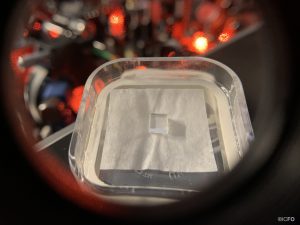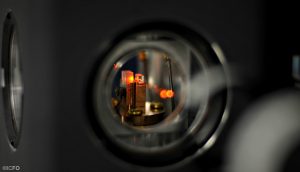Entangled quantum memories for a quantum repeater: A step closer to the Quantum Internet
ICFO researchers report in this week’s Nature issue on having achieved, for the first time, entanglement of two multimode quantum memories located in different labs separated by 10 meters and heralded by a photon at the telecommunication wavelength.
During the 90s, engineers made major advances in the telecom arena spreading out the network to distances beyond the cities and metropolitan areas. To achieve this scalability factor, they used repeaters, which enhanced attenuated signals and allowed these to travel farther distances with the same features such as intensity or fidelity. Now, with the addition of satellites, it is completely normal to be in the middle of a mountain in Europe and talk with your loved ones living in the other part of the world.
In the road towards building the future Quantum Internet, quantum memories play the same role. Together with sources of qubits, they are the building blocks of this novel internet, acting as quantum repeaters of data operations and using superposition and entanglement as the key ingredients of the system. But to operate such a system at a quantum level, the entanglement between quantum memories had to be created over long distances and maintained as efficiently as possible.
All together in one
In a study published today in Nature, ICFO scientists Dario Lago, Samuele Grandi, Alessandro Seri, and Jelena Rakonjac, led by ICREA Prof at ICFO and QuantumCAT Communication coordinator Hugues de Riedmatten, have achieved scalable, telecom-heralded matter-matter entanglement between two remote, multimode and solid-state quantum memories. In simpler words, they were able to store, for a maximum of 25 microseconds, one single photon in two quantum memories placed 10m apart.

The researchers knew that the photon was in one of the two memories, but they did not know in which one, which emphasized this counter-intuitive notion that we have of nature, which allows the photon to be in a quantum superposition state in the two quantum memories at the same time but, amazingly, 10 meters apart. The team also knew that the entanglement was created with the detection of a photon at telecom wavelength, and it was stored in the quantum memories in a multiplexed fashion, “a feature akin to allowing several messages to be sent at the same time in a classical channel”. These two key features have been achieved together for the first time and define the stepping stone in extending this scheme to much longer distances.
As Dario Lago, a PhD student at ICFO and first author of the study enthusiastically pinpoints “So far, several of the milestones achieved in this experiment were done by other groups, like entangling quantum memories or achieving storage of the photons in quantum memories with very high efficiency and high rates. But, the uniqueness about this experiment is that our techniques achieved very high rates and can be extended to longer distances.”
Setting up the experiment
Achieving this landmark took its effort and time. During the course of several months, the team set up the experiment, where they used a rare-earth-doped crystal as a quantum memory for the basis of their test.
Then, they took two sources generating correlated pairs of single photons. In each pair, one photon, named idler, is at a 1436nm (telecom wavelength), and the other, named signal, is at a wavelength of 606nm. The single signal photons were sent to a quantum memory, made up of millions of atoms all randomly placed inside a crystal, and stored there via a protocol called atomic frequency comb. Alongside, the idler photons also called heralding or messenger photons were sent through an optical fiber to a device called beam-splitter, where the information about their origin and path was completely erased. Samuele Grandi, postdoctoral researcher and co-first author of the study, comments, “We erased any sort of feature that would tell us where the idler photons were coming from, let it be source 1 or 2, and we did this because we did not want to know any information about the signal photon and in which Quantum Memory it was being stored in”. By erasing these features, the signal photon could have been stored in any of the quantum memories, which means that entanglement was created between them.

Every time that the scientists saw on the monitor a click of an idler photon arriving at the detector, they were able to confirm and verify that there was, in fact, entanglement. This entanglement consisted in a signal photon in a superposition state between the two quantum memories, where it was stored as an excitation shared by tens of millions of atoms for up to 25 microseconds.
As Sam and Dario mention, “The curious thing about the experiment is that it is not possible to know if the photon was stored in the quantum memory in the lab 1 or in Lab 2, which was more than 10 meters away. Although this was the principal feature of our experiment, and one that we kind of expected, the results in the lab were still counter-intuitive, and even more peculiar and mind-blowing to us is that we were capable of controlling it!”
Future Steps
As Prof. ICREA at ICFO Hugues de Riedmatten enthusiastically remarks “This idea was conceived more than 10 years ago and I am thrilled to see that it has now succeeded in the lab. The next steps are to bring the experiment outside of the lab, to try and link different nodes together and distribute entanglement over much larger distances, beyond what we currently have now. In fact, we are in the midst of achieving the first quantum link of 35km, which will be done between Barcelona and ICFO, in Castelldefels”.
It is clear that the future quantum network will bring many applications in the near future. This achieved landmark proves and confirms that we are in the correct pathway towards developing these disruptive technologies and beginning to deploy them into what will be a new way of communicating, the Quantum Internet.
Cited article:
Dario Lago-Rivera, Samuele Grandi, Jelena V. Rakonjac, Alessandro Seri, and Hugues de Riedmatten. Telecom-heralded entanglement between multimode solid-state quantum memories. Nature, 2021.
Read more at ICFO newsroom.